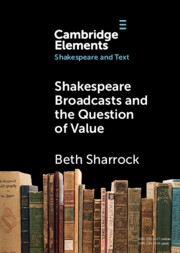Refine search
Actions for selected content:
164 results
17 - The Mid Century Canon
-
-
- Book:
- The Cambridge History of Australian Poetry
- Published online:
- 19 November 2025
- Print publication:
- 11 December 2025, pp 313-334
-
- Chapter
- Export citation
10 - ‘Poetry Is Its Own Advertisement’
-
-
- Book:
- The Cambridge History of Australian Poetry
- Published online:
- 19 November 2025
- Print publication:
- 11 December 2025, pp 188-207
-
- Chapter
- Export citation
Impact factor: Playing a number on you
-
- Journal:
- Quantitative Plant Biology / Volume 6 / 2025
- Published online by Cambridge University Press:
- 14 November 2025, e33
-
- Article
-
- You have access
- Open access
- HTML
- Export citation
Chapter 5 - A Tale of Two Print Cultures
- from Part I - Producing Print
-
-
- Book:
- African Literature in Transition
- Published online:
- 23 October 2025
- Print publication:
- 06 November 2025, pp 112-128
-
- Chapter
- Export citation
Chapter 4 - (Post)colonial Books as Commodity and Anti-Commodity
- from Part I - Origins
-
-
- Book:
- Commodities and Literature
- Published online:
- 14 October 2025
- Print publication:
- 09 October 2025, pp 76-96
-
- Chapter
- Export citation
12 - Dissemination
-
- Book:
- Applying Corpus Linguistics to Illness and Healthcare
- Published online:
- 05 September 2025
- Print publication:
- 25 September 2025, pp 186-200
-
- Chapter
-
- You have access
- Open access
- HTML
- Export citation
The current state of paediatric publishing utilising high-fidelity physiologic data streaming with sickbay or etiometry: a systematic review
-
- Journal:
- Cardiology in the Young / Volume 35 / Issue 9 / September 2025
- Published online by Cambridge University Press:
- 05 September 2025, pp. 1809-1814
-
- Article
- Export citation
3 - Publishing for Professional Advantage
-
- Book:
- Selling Sexual Knowledge
- Published online:
- 24 June 2025
- Print publication:
- 10 July 2025, pp 90-120
-
- Chapter
-
- You have access
- Open access
- HTML
- Export citation
Introduction
-
- Book:
- Selling Sexual Knowledge
- Published online:
- 24 June 2025
- Print publication:
- 10 July 2025, pp 1-21
-
- Chapter
-
- You have access
- Open access
- HTML
- Export citation
Subversion of publishing comes to a boil: is it time to lance it?
-
- Journal:
- The British Journal of Psychiatry / Volume 227 / Issue 2 / August 2025
- Published online by Cambridge University Press:
- 08 July 2025, pp. 517-518
- Print publication:
- August 2025
-
- Article
-
- You have access
- HTML
- Export citation
Chapter 5 - CantoMundo, Undocupoets, Letras Latinas, and the Cultivation of Latinx Poetry
- from Part I - Shifting Coordinates
-
-
- Book:
- Latinx Literature in Transition, 1992–2020
- Published online:
- 19 June 2025
- Print publication:
- 03 July 2025, pp 96-112
-
- Chapter
- Export citation

Selling Sexual Knowledge
- Medical Publishing and Obscenity in Victorian Britain
-
- Published online:
- 24 June 2025
- Print publication:
- 10 July 2025
-
- Book
-
- You have access
- Open access
- Export citation
The value of mental science: we publish what matters
-
- Journal:
- The British Journal of Psychiatry / Volume 227 / Issue 1 / July 2025
- Published online by Cambridge University Press:
- 09 June 2025, pp. 429-433
- Print publication:
- July 2025
-
- Article
-
- You have access
- HTML
- Export citation
7 - Manufacturing the Nautical Almanac
-
-
- Book:
- The Board of Longitude
- Published online:
- 11 April 2025
- Print publication:
- 17 April 2025, pp 157-191
-
- Chapter
- Export citation
11 - Confronting the Crises in Peer Review and Academic Publishing
- from Part II - Rethinking Research
-
- Book:
- Rethinking Clinical Research
- Published online:
- 13 March 2025
- Print publication:
- 20 March 2025, pp 217-231
-
- Chapter
- Export citation
Chapter 1 - Life and Times
-
- Book:
- The Cambridge Introduction to Samuel Johnson
- Published online:
- 07 February 2025
- Print publication:
- 13 February 2025, pp 1-22
-
- Chapter
- Export citation
Ethical approval of studies involving humans and other animals
-
- Journal:
- Animal Welfare / Volume 34 / 2025
- Published online by Cambridge University Press:
- 12 February 2025, e12
-
- Article
-
- You have access
- Open access
- HTML
- Export citation
The Revolution Must Be Published: Toward a Radically Inclusive Publishing Ecology
- Part of
-
- Journal:
- Public Humanities / Volume 1 / 2025
- Published online by Cambridge University Press:
- 10 February 2025, e47
-
- Article
-
- You have access
- Open access
- HTML
- Export citation

Shakespeare Broadcasts and the Question of Value
-
- Published online:
- 07 February 2025
- Print publication:
- 06 March 2025
-
- Element
- Export citation
Chapter 1 - Bookness
-
- Book:
- E-books and ‘Real Books’
- Published online:
- 07 December 2024
- Print publication:
- 23 January 2025, pp 14-34
-
- Chapter
-
- You have access
- Open access
- HTML
- Export citation
